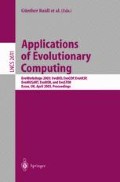Abstract
ArtiE-Fract is an interactive evolutionary system designed for artistic exploration of the space of fractal 2D shapes. We report in this paper an experiment performed with an artist, the painter Emmanuel Cayla. The benefit of such a collaboration was twofold: first of all, the system itself has evolved in order to better fit the needs of non-computerscientist users, and second, it has initiated an artistic approach and open up the way to new possible design outputs.
Access this chapter
Tax calculation will be finalised at checkout
Purchases are for personal use only
Preview
Unable to display preview. Download preview PDF.
References
P. J. Angeline, “Evolving Fractal Movies”, GP 1996: Proceedings of the First Annual Conference, John R. Koza and David E. Goldberg and David B. Fogel and Rick L. Riolo (Eds), pp 503–511, 1996.
W. Banzhaf, “Interactive Evolution”, Handbook of Evolutionary Computation, 1997, Oxford Univ. Press.
M. F. Barnsley, “Fractals Everywhere,” Academic Press, New-York, 1988.
M. F. Barnsley and S. Demko, “Iterated Functions System and the Global Construction of Fractals,” Proceedings of the Royal Society, A 399:243–245, 1985.
E. Cayla, “Tapis-bulles 1,” prototype d’une approche multi-agents des formes et des couleurs, 3èmes journees francophones sur l’IA distribuees et les systemes multiagents. Chambéry 1995
E. Cayla, “L’atelier des tapis-bulles’, interprétation et ” compression des poèmes graphiques”, Journees d’etudes et d’echanges “Nouvelles techniques pour la compression et la représentation des signaux audiovisuels”, CNET-CCETT, Cesson-Sévigné, 1995
E. Cayla, “D’un logiciel de CAO aux variations Goldberg de Bach”, Le micro bulletin, CNRS n.53, pp. 162–182, 1994 (Communication produite aux entretiens du Centre Jacques Cartier, Montréal 1992)
J. Chapuis and E. Lutton, “ArtiE-Fract: Interactive Evolution of Fractals”, 4th International Conference on Generative Art, Milano, Italy, December 12–14, 2001.
P. Collet, E. Lutton, F. Raynal, and M. Schoenauer, “Individual GP: an Alternative Viewpoint for the Resolution of Complex Problems,” GECCO 99, Genetic and Evolutionary Computation Conference, Orlando, Florida, USA, July 13–17, 1999.
P. Collet, E. Lutton, F. Raynal, M. Schoenauer, “Polar IFS + Parisian Genetic Programming = Efficient IFS Inverse Problem Solving”, Genetic Programming and Evolvable Machines Journal, Volume 1, Issue 4, pp. 339–361, October 2000.
B. Forte, F. Mendivil and E.R. Vrscay, ‘Chaos Games’ for Iterated Function Systems with Grey Level Maps, SIAM Journal of Mathematical Analysis, vol 29, No 4, pp 878–890, 1998. http://citeseer.nj.nec.com/146020.html
D. A. Goldberg, “Genetic Algorithms in Search, optimisation, and Machine Learning,” Addison-Wesley Publishing Company, inc., Reading, MA, January 1989.
J. Hutchinson, “Fractals and Self-Similarity,” Indiana University Journal of Mathematics, 30:713–747, 1981.
A.E. Jacquin, “Fractal Image Coding: a Review,” Proc. of the IEEE, 81(10), 1993.
S. Kamohara, H. Takagi and T. Takeda, “Control Rule Acquisition for an Arm Wrestling Robot”, in IEEE Int. Conf. on System, Man and Cybernetics (SMC’97), vol 5, Orlando, FL, USA, 1997.
J. Lévy Véhel, F. Paycha and J.-M. Rocchisani Multifractal Measurements of Lung Diseases In First International Conference on Fractals in Biology and Medicine, 1993.
E. Lutton, J. Lévy Véhel, G. Cretin, P. Glevarec, and C. Roll, “Mixed IFS: resolution of the inverse problem using genetic programming,” Complex Systems, 9:375–398, 1995.
P. Machado, A. Cardoso, All the truth about NEvAr. Applied Intelligence, Special issue on Creative Systems, Bentley, P. Corne, D. (eds), Vol. 16, Nr. 2, pp. 101–119, Kluwer Academic Publishers, 2002.
N. Monmarche, G. Nocent, G. Venturini, and P. Santini. “On Generating HTML Style Sheets with an Interactive Genetic Algorithm Based on Gene Frequencies”, AE 99, Dunkerque, France, November 1999, Selected papers, Springer Verlag, LNCS 1829, 1999.
R. Poli and S. Cagnoni, “Genetic Programming with User-Driven Selection: Experiments on the Evolution of Algorithms for Image Enhancement”, in 2nd Annual Conf. on GP, pp 269–277, 1997.
S. Rooke, “The Evolutionary Art of Steven Rooke” http://www.azstarnet.com/~srooke/
F. Raynal, E. Lutton, P. Collet, “Manipulation of Non-Linear IFS Attractors Using Genetic Programming” CEC99, Congress on Evolutionary Computation, Washington DC, USA, July 6–9, 1999.
D. Saupe and R. Hamzaoui, A bibliography for fractal image compression. Institut für Informatik, Universität Freiburg, Germany. 1996. Available as ftp://www.informatik.uni-freiburg.de/documents/papers/fractal/biblio.ps.gz.
K. Sims, “Artificial Evolution for Computer Graphics,” Computer Graphics, 25(4):319–328, July 1991.
H. Takagi, M. Ohsaki, “IEC-based Hearing Aids Fitting”, IEEE Int. Conf. on System, Man and Cybernetics (SMC’99), Tokyo, Japan, vol 3, pp 657–662, Oct. 12–15, 1999.
H. Takagi, “ Interactive Evolutionary Computation: System Optimisation Based on Human Subjective Evaluation”, IEEE Int. Conf. on Intelligent Engineering Systems (INES’98), Vienna, Austria, pp 1–6, Sept 17–19, 1998.
S.J.P. Todd and W. Latham, Evolutionary Art and Computers, Academic Press, 1992.
Author information
Authors and Affiliations
Editor information
Editors and Affiliations
Rights and permissions
Copyright information
© 2003 Springer-Verlag Berlin Heidelberg
About this paper
Cite this paper
Lutton, E., Cayla, E., Chapuis, J. (2003). ArtiE-Fract: The Artist’s Viewpoint. In: Cagnoni, S., et al. Applications of Evolutionary Computing. EvoWorkshops 2003. Lecture Notes in Computer Science, vol 2611. Springer, Berlin, Heidelberg. https://doi.org/10.1007/3-540-36605-9_47
Download citation
DOI: https://doi.org/10.1007/3-540-36605-9_47
Published:
Publisher Name: Springer, Berlin, Heidelberg
Print ISBN: 978-3-540-00976-4
Online ISBN: 978-3-540-36605-8
eBook Packages: Springer Book Archive

